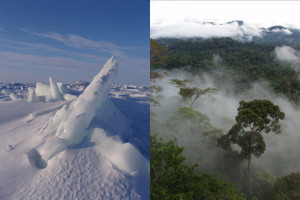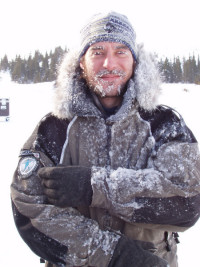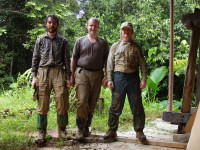Studying the atmosphere from the Arctic to the Tropics
Scientists from the Centre for Atmospheric Science have recently participated in major field projects in the rainforest of Borneo and on Arctic sea ice, with some individuals being heavily involved in both projects.
These projects, named OP3 (Oxidant and particle photochemical processes above a South-East Asian tropical rain forest), and COBRA(Impact of combined iodine and bromine release on the Arctic atmosphere) respectively were studies of the natural processes which take place in the atmosphere. An understanding of these processes is critical in our understanding of the global atmosphere/climate system as a whole, but in many cases, especially in remote locations these processes are poorly understood and quantified. Natural processes govern important gas phase and aerosol properties such as oxidative capacity and CCN concentration in these regions, which in turn have an impact on longevity of greenhouse gases and cloud properties. Changes in these processes brought about by local human activities, or by global warming may have significant climatic effects. Further information about these projects may be found by following the links below.
Impact of combined iodine and bromine release on the Arctic atmosphere (COBRA)
Oxidant and particle photochemical processes above a South-East Asian tropical rain forest (OP3)
Operating in these environments brings a whole set of different challenges in addition to those experienced in operating a major project in the UK for example. These challenges extend to logistical, technical and human aspects of the project. The biggest technical challenge in both these projects related to extremes of temperature and in Borneo the related problem of water vapour and condensation. Additional challenges included power cuts, lightning strikes, tropical downpours and blown snow. Human aspects in addition to working in a harsh environemnt included the isolation of living in a remote location, and in Borneo at times a lack of basic ameneties such as running water and electricity at the field centre.
Field projects often take us to remote and beautiful locations around the world, but these two projects will probably go down as being amongst the most challenging we have attempted in recent years, with a combination of living and working in a remote location coupled with the technical and logistical challenges of the project. Until you actually work in these environments it is hard to appreciate just how much more difficult it is to carry out what would normally be relatively simple tasks. In Hudson Bay for example, tasks such as putting nuts and washers onto bolts, or manipulating cables became much more difficult, working with thick gloves and cold brittle cables. At -40C with a little wind and blowing snow, you do not have very many minutes to work between removing your gloves and being forced to put them back on again.
Over the last few months we have gone from pulling a sled across the sea ice at almost -40C to dragging equipment up a slippery muddy track in a tropical downpour at almost 30C, from cutting holes through the ice to installing lightning protection, and from encountering arctic foxes to leaches, snakes and scorpions. It certainly cannot be said that life is boring as an atmospheric field scientist.


